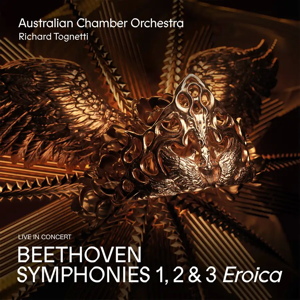
Ludwig van Beethoven (1770-1827)
Symphony No. 1
Symphony No. 2
Symphony No. 3 Eroica
Australian Chamber Orchestra/Richard Tognetti
rec. live, 11-16 February 2020, City Recital Hall, Sydney, Australia
ABC Classics ABCL0077 [2CDs: 102]
In his chirpy note to this issue, “Musings on B1, 2, 3”, Artistic Director and lead violinist of the Australian Chamber Orchestra Richard Tognetti makes some remarks which go a long way to explaining the thinking behind, and features of, the playing encountered here.
First, he is clearly keen to distance himself and the ACO’s interpretations from too reverential an approach, mocking E.T.A. Hoffmann’s response to Beethoven with the comment, “How difficult it is to write about B” – note the casual abbreviation – “without exhibiting a lofty sense of grandeur.” Ah yes; in this cynical modern age, anything which smack of nobility and elevation must be levelled down or preferably “cancelled.”
Secondly, in the paragraph beginning “Wham Bam Thank you AMAM” – evidently phrased in order to capitalise upon, and indeed glorify, Australia’s reputation for crass, unabashed vulgarity – he stresses that the ACO consists of an amalgam of highly talented players from around the world – “among the best on the planet”, who were assembled for the concerts. In other words, they are not an established ensemble who have that understanding which exists among musicians who have worked together over a period of time. This might explain why, when listening to these live accounts, I have the impression of a technically superb sight-reading of the score devoid of interpretative nuance or variety.
This perhaps links with the third factor: that the ensemble is led by Tognetti while he is playing first desk. He whimsically answers the paragraph heading, “Conductorless?” with “Strange, silent dictator, not”. I appreciate that I am fast manoeuvring myself into the position of “po-faced gammon” by finding this rather disrespectful of the conducting profession, but I would nonetheless suggest that he should eschew such humorous forays until the ACO’s musical achievements are the equal of other such “headless” orchestras as the Orpheus Chamber Orchestra.
Fourthly, Tognetti remarks that the players use original, gut-stringed instruments “which are always full of character” – precisely the quality I find to be missing in these renderings. This may again be linked to the fifth and final factor: that just as “you don’t argue with [Beethoven’s] keys or time signatures. Why take on his metronome markings?”. The ACO has chosen to apply them literally, with the result that to many ears they will sound absurdly rushed and perfunctory. For example, the supposedly Adagio opening of the Second goes for nothing. However, timings are never the only measure of whether a tempo works; hence Gerd Schaller’s chamber of the Eroica (review) with an even smaller orchestra is almost as fast but I describe it as “a fleet but grand account, suffused with inner tension.” Going back sixty years to Konwitschny’s famously propulsive recordings of the whole cycle, I see that there is precious little difference between his timings for the first two symphonies and Tognetti’s except for that same opening movement of the Second – yet I find in his readings all the phrasal and dynamic variety missing in the ACO’s performances. I know that the First is the most “classical” of the symphonies but every one of its varied moods is skimmed over here, so keen are its interpreters to avoid “Romantic” associations.
This band of forty-five players is of course smaller than the usual symphony orchestra – no doubt nearer to what the composer was used to but not necessarily what he would have preferred.
The sound is excellent and well-balanced; individual strands of the score emerge and I like the prominence of the hard-stick timpani. The music itself is so wonderful and the playing so expert that there is still much to enjoy here, especially the sheer dexterity of the strings playing at such speeds – particularly in the Allegro con brio passage following that slow opening of the Second – but for me there is too much of a “Keystone Cops” element to that proficiency.
This is the first Australian recording of these symphonies on original instruments and judging by the applause which ensues, the audience thoroughly enjoyed it; I suspect that its impact was greater live by virtue of its sheer, breathless pace but it is not for more considered listening.
Ralph Moore
Help us financially by purchasing from


















